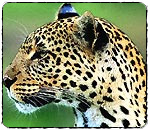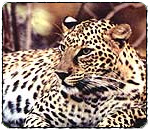|
About |
|
These cats have an elongate and muscular body. Their paws are broad and their ears are short. In tropical regions their coats tend to be shorter and sleeker, whereas in colder climates their fur is longer and denser. The coloration varies from the color of straw to grayish to even chesnut. The backs of the ears are black except for a spot either located centrally or near the tips. |
|
These appear to other animals as eyes. The throat, chest, belly, and the insides of the limbs are white. The rest of the head, throat, chest, and limbs all have small black spots. The belly has larger black spots, almost like blotches. Region and habitat have an affect on the appearance of P. pardus. |
|
In Africa, leopards living in hilly areas tend to be larger
 than those living in
lowlands. There is a tendency to melanism (black coloration) in this species. This characteristic is more frequent in densely forested areas where being darker is probably beneficial in remaining unseen as compared to open areas. Whether spotted or black, leopards' coloration is extremely effective. Scientists have been unable to spot these cats just a few yards away even knowing that they were present. Leopards have been recorded as long as 2.92 meters but that is extreme, 1.37-1.67 is more common. than those living in
lowlands. There is a tendency to melanism (black coloration) in this species. This characteristic is more frequent in densely forested areas where being darker is probably beneficial in remaining unseen as compared to open areas. Whether spotted or black, leopards' coloration is extremely effective. Scientists have been unable to spot these cats just a few yards away even knowing that they were present. Leopards have been recorded as long as 2.92 meters but that is extreme, 1.37-1.67 is more common. |
|
Habitat |
|
Pantera pardus could at one time be found from British Isles to Japan and throughout most of Asia. Today they can still be found in Africa, except for the true deserts of Sahara and Kalahari, and some parts of Asia such as Sri Lanka. Leopards are more common in Eastern and Central Africa. Conversely, they are rare in Western and Northern Africa and most of Asia (Nowak, 1997; Sanderson, 1972). |
|
Behavior |
|
Leopards are famous for their ability to go undetected. They may live practically among humans and still be tough to spot. They are graceful and stealthy. Amongst the big cats they are probably the most accomplished stalkers. They are good, agile climbers and can descend from a tree headfirst. Along with climbing, they are strong swimmers but not as fond of water as tigers; for example, leopards will not lay in water. They are mainly nocturnal but can be seen at any time of day and will even hunt during daytime on overcast days. |
|
In regions where they are hunted, nocturnal behavior is more common. These
 cats are solitary, avoiding one
another. However, 3 or 4 are sometimes seen together. Hearing and eyesight are the strongest of these cats' senses and are extremely acute. Olfaction is relied upon as well, but not for hunting. When making a threat, leopards stretch their backs, depress their rib cages between their shoulder blades so they stick out, and lower their heads (similar to domestic cats). During the day they may lie in bush, on rocks, or in a tree with their tails hanging below the treetops and giving them away. cats are solitary, avoiding one
another. However, 3 or 4 are sometimes seen together. Hearing and eyesight are the strongest of these cats' senses and are extremely acute. Olfaction is relied upon as well, but not for hunting. When making a threat, leopards stretch their backs, depress their rib cages between their shoulder blades so they stick out, and lower their heads (similar to domestic cats). During the day they may lie in bush, on rocks, or in a tree with their tails hanging below the treetops and giving them away. |
|
Food Habits |
|
The diet of these big cats is surprisingly varied. Prey for this species includes: wildebeest, impalas, reed-bucks, Thomson's gazelles, jackals, baboons, and storks. These are the most common food sources with Thomson's gazelles and reed-bucks making up the majority. However, other prey are included in leopards' diet. At times they seem to show a preference for canines, even attempting in the past to snatch dogs right from the feet of their masters. |
|
They will eat fish and domestic stock such as goats. They will even eat carrion, scavenging tiger kills. These cats are capable of sneaking right up next to the prey before being spotted, almost appearing from nowhere. Bite marks occur on the nape of the neck and the throat. The bite on the back of the neck often occurs when animals are attacked from behind. |
|
Lifespan / Longevity |
|
Leopards live 21-23 years in captivity. In the wild, life span is not exactly known. It can be approximated from reports of "man-eaters" (see negative effects), which are easier to follow; from the beginnings of their attacks until the end, life span in the wild can be estimated around to be 7-9 years. |
|
Expected Lifespan In Wild: 7 to 9 years
Expected Lifespan In Captivity: 21 to 23 years |
|
Economic Importance for Humans |
|
Positive |
|
The skins of these cats have been sought after throughout history. There is still a market for them today, although much of the hunting is illegal. Produces - Fur, leather or wool. |
|
Negative |
|
When living near populated areas these cats will attack and kill domestic stock such as goats and pigs. Where this prey is provided leopards will achieve unusually high densities and the problem persists. They will also attack and kill humans. One particular leopard in India, known as "Kahani man-eater" killed over 200 people although this behavior is not the norm. |
|
Bites or stings |
|
Conservation |
|
The status of P. pardus ranges from endangered to critically endangered to threatened depending on the geographic region. Even though these cats are highly adaptable, they still face many problems. These include habitat
destruction, being hunted as trophies and for their fur, and persecution as killers. Illegal hunting of leopards for their fur became so common in the 1960s that as many as 50,000 skins were marked annually. |
|
Top |